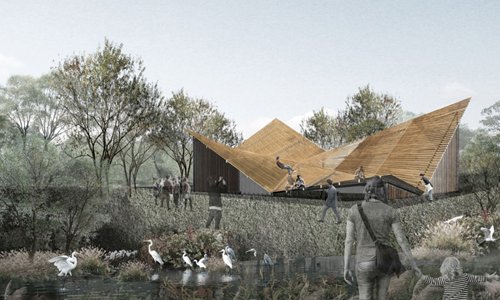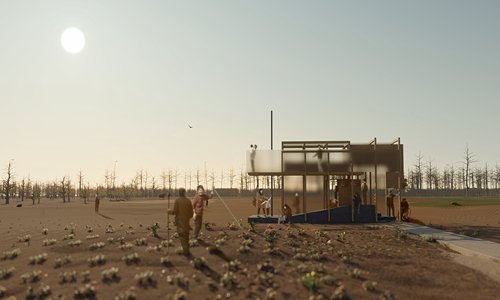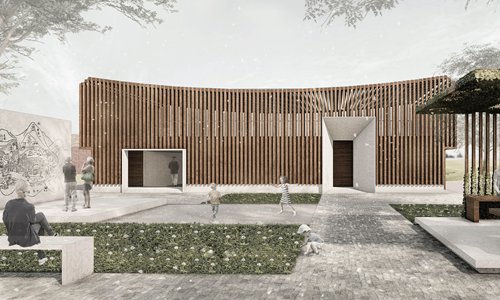HOME >> ARTS
Chinese and international students seek to revitalize century-old pear orchard in East China town
By Bi Mengying in Suqian Source:Global Times Published: 2019/8/4 18:10:28

A mock-up of Lie Between by Tsinghua University and University of Ljubljana Photo: Courtesy of Tsinghua University and University of Ljubljana

A mock-up of cabin by the China Academy of Art and National Technical University of Athens Photo: Courtesy of the China Academy of Art and National Technical University of Athens

A mock-up of teahouse cabin by Xi'an University of Architecture and Technology and Politecnio di Milano Photo: Courtesy of Xi'an University of Architecture and Technology and Politecnio di Milano
Held in different villages across China every year, the workshop is co-hosted by the International Union of Architects (UIA), the government of Siyang county, China Building Center (CBC) and the School of Architecture at Tianjin University. It is the first year for UIA to join the hosts of the workshop, while CBC has remained the host for the past three years.
Quite a 'pear'ing
This year, Chinese mainland college students were asked to pair up with students from Hong Kong, Macao, Taiwan or abroad to form a "1+1 joint team."
Focusing on the more than 100-year-old pear orchard at Aiyuan township in Siyang, the theme for this year is to build "pear orchard cabins" that can help revitalize the village and orchard. An open-call for registration was issued in January. By the submission deadline on March 31, 101 colleges and universities from 23 countries and regions submitted plans. After review, a final 15 teams were selected to take part in the workshop and bring their designs to life.
Konstantinos Kostopoulos, an assistant professor at the National Technical University of Athens, moved back to Greece from China in summer of 2018. From 2013 to 2018, he worked as an assistant professor at the University of Nottingham Ningbo China. When he heard about this great opportunity, he used his personal contacts with the China Academy of Art (CAA) to form a joint team and enter the competition.
"It has been a challenge in many ways. First, choose the students who are going to participate… we selected the participating students through an internal competition. The next challenge was to create a joint design while being 8,000 kilometers apart. We organized a series of design sessions followed by joint reviews via video conference. Despite all odds, we managed the process well and managed to produce a design that incorporated ideas from both teams and succeeded in being selected among the 15 finalists for the construction phase," Kostopoulos told the Global Times.
Local symbol
Siyang county is well-known for its delicious pears. Among the many pear trees in Aiyuan, seven in particular are known as the "Seven Gentlemen." Local legend has it that these seven pear trees were planted back in 1773 during reign of the Qianlong Emperor. After more than 200 years, the Seven Gentlemen continue to flourish among the hundreds of peach trees in the village.
Villagers sell the trees' fruits and make handicrafts out of their branches. When the blooming season arrives, tourists are drawn to the county for the Pear Blossom Festival. While the Aiyuan pear orchard to some extent has become a symbol of Siyang over the centuries, how to infuse vibrancy and further its development is one of the challenges the local government faces.
The workshop teams were required to use the branches of the pear trees as materials for decorations and take local characteristics such as the Pear Blossom Festival and pear processing industry into consideration when designing the cabins and infrastructure that they feel will benefit the lives of the villagers.
Calling tired souls
The designs by the 15 teams varied in style and location. One of the highlights is Lie Between, an outdoor theater by the Tsinghua University + University of Ljubljana team.
During the team's field visits to Aiyuan county in the run up to the workshop, they found that many of the village's young residents have moved to larger cities to work, leaving only children and the elderly behind. The team hopes that the theater will serve as a spiritual shelter by enriching the cultural life of the children and senior residents.
The design of the building makes it appear as a haystack, reminding villagers and returnees of the time when they used to lie down on haystacks and watch the stars in the quiet countryside sky at night as children. It appears to be calling tired souls home, away from busy city life.
Shared passion
"English is not the native language for Chinese or Slovenes, so it isn't easy for us to communicate in English," Lei Yuxin, a student from Tsinghua University, told the Global Times. Yet she noted that their shared passion for architecture and professional skills have become a common language for them.
Similarly, Wang Yuqi, a student from the Xi'an University of Architecture and Technology, pointed out that the workshop has brought them closer together with the members of the team from the Politecnio di Milano in Italy.
"Professor Laura Anna Pezzetti is so nice, and we all call her 'Teacher Lao' [Lao being close to the pronunciation of Laura]... She used to eat bread and milk for dinner at first, but after spending some time with us, she can order fried rice and Bingfeng [a Chinese soft drink brand] in Chinese. She's on her way to becoming a zhongguotong [a person who knows much about China]," said Wang.
Newspaper headline: Design and development
RELATED ARTICLES:
- Changdeokgung Palace in Seoul, masterpiece of architecture
- UN Geneva hosts exhibition on Chinese architecture along ancient Silk Road
- Chinese VP calls for shaping global architecture for better future of mankind
- Apple architecture
- Shanghai’s skyline boasts a number of historic Christian architecture
Posted in: CULTURE & LEISURE,WHAT’S ON